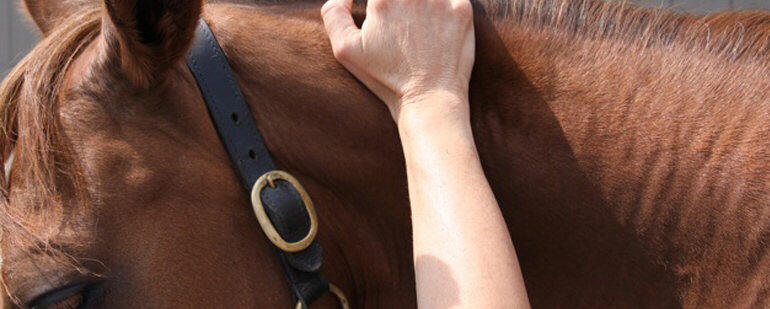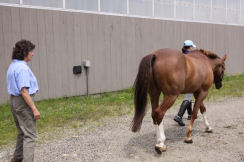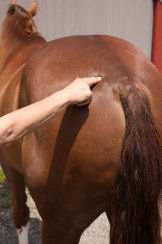|
 |
CASE STUDY: SHORTENED STRIDE FROM HIND LEG. LESS PUSH FROM HIND LEG.A top rider called me, voicing great concern about his international competition horse because the horse was short behind, and not stepping underneath his body with his right hind leg. The horseís push with the right hind was also diminished. The horse was going to be shipping to compete in a qualifier for an international competition in three weeks. I understood the riderís concern since a fraction of an inch makes a difference in a competition. I told the rider that if the origin of the problem was coming from a tight muscle, I could likely restore the range of motion to the horseís hind leg with one or two treatments. (I believe if it is the correct treatment, results should be reached within one to two treatments. If results do not occur in two treatments, then it is not the correct treatment!).
The process I used to solve this common motion problem was to simply think about which muscles draw the hind leg back behind the body. Once I identified which muscles draw the hind leg backward, then I questioned if these are the muscles that are not releasing to allow the leg to move forward. With these very simple questions of back and forth or pull and release, the problem can theoretically be solved. I say theoretically, because the next piece of the detective work was to use palpation skills with my hands to determine if the identified muscles felt tight. I watched the horse walk in a straight line, since I get the best view of muscle function at the walk. The horse showed a shortened stride at the walk in the right hind leg. I immediately suspected the hamstrings. The three hamstrings basically draw the leg back. They extend the hip, flex the stifle, and assist in extending the hock. Again, basically drawing the hind leg backward. I knew if these muscles were tight, and did not fully release, then the horse would have a shortened stride behind. Secondly, I determined the hamstrings were very tight through palpation. The biceps femoris, one of the three hamstrings was the tightest on the horse. The biceps femoris is the most complex of the three hamstrings because it is composed of three parts, effects three joints, and is not a straight muscle by natureís design. Anything that is not straight is at greater risk for injury.
When I asked the rider
to jog the horse out in a straight line and ride the horse for me after
the treatment, the horse was much looser, and was able to step
underneath his body eliminating the problem of a shortened stride. Since
follow up exercise is part of the Wilson Meagher Method of
sportsmassage, I suggested the rider canter the horse in an easy,
connected frame a few times in both directions around the arena to
further lengthen the muscles. The results were, and often are immediate.
The rider was so happy, he bought me lunch! Cause: The job was not complete because we needed to determine why the hamstring was tight in the first place. After reviewing the riderís training schedule, and determining that the rider varied his work, warmed and cooled the horse down adequately, I needed to think outside of the box. The rider turned the horse out in a new field which had a slight hill. The grass was thick and rich, but the rain that came down for the entire past week, made the lovely field a slick messy pasture. We determined the horse must have slipped on the hill with wet footing and stressed the hamstrings which can be easily done on slippery footing. Remember, the horse was not lame or injured, but just looked and felt shorter in the right hind leg as a result of simple muscle tightness. The horse and rider shipped to the qualifier and successfully represented their country in the international competition!
|
 |


 Problem
Solving: Since all muscles pull, and that is all they do in terms of
motion, I needed to think in terms of the biomechanics to begin to solve
the shortened stride problem. It is the release process of the muscle
that is effected by simple muscle tightness. When muscles are tight,
they do not release easily for the opposite motion to occur.
Thinking about which muscles are not releasing is critical to solving
the problem. A simple example is a person who has tight back muscles.
The back muscles are responsible for extending the spine and keeping the
person erect and standing upright. If these same back muscles in a
person are tight, they may not release fully to allow for flexion of the
spine, or bending forward.
Problem
Solving: Since all muscles pull, and that is all they do in terms of
motion, I needed to think in terms of the biomechanics to begin to solve
the shortened stride problem. It is the release process of the muscle
that is effected by simple muscle tightness. When muscles are tight,
they do not release easily for the opposite motion to occur.
Thinking about which muscles are not releasing is critical to solving
the problem. A simple example is a person who has tight back muscles.
The back muscles are responsible for extending the spine and keeping the
person erect and standing upright. If these same back muscles in a
person are tight, they may not release fully to allow for flexion of the
spine, or bending forward.  Solution:
I worked on all three hamstrings using the three techniques of the
Wilson Meagher Method. The techniques which are anatomically accurate,
included direct pressure, cross fiber friction and compressions to the
entire muscles and their attachments. The muscleís pliability was
restored, thus feeling very soft and much looser. I also worked on the
entire horse, since compensatory muscle tightness occurs and it is
important to always work on the entire body.
Solution:
I worked on all three hamstrings using the three techniques of the
Wilson Meagher Method. The techniques which are anatomically accurate,
included direct pressure, cross fiber friction and compressions to the
entire muscles and their attachments. The muscleís pliability was
restored, thus feeling very soft and much looser. I also worked on the
entire horse, since compensatory muscle tightness occurs and it is
important to always work on the entire body.